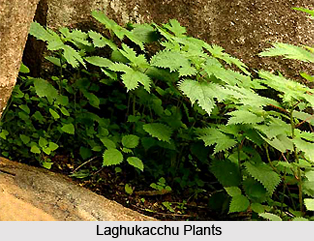 The scientific name for Laghukacchu is Girardinia Diversifolia. The Bichua is commonly found in the hills of western and southern India, especially in Rajasthan, Madhya Pradesh and Kerala. In the north Indian provinces like Punjab this Indian medicinal plant is known as Anjan, Bhabar, Kal, Keri, Kingi and Sanoli; in Hindi it is identified as Alia, Awa, Bichua and Chichr. Almost all Indian plants have separate Sanskrit names and Laghukacchu is no exception. This very name has also evolved from Sanskrit. In Kannada Laghukacchu is recognised as Turike and in Malayalam it is called Anachchoriyanam. In Maharashtra this Indian medicinal plant is popular as Motikhajati.
The scientific name for Laghukacchu is Girardinia Diversifolia. The Bichua is commonly found in the hills of western and southern India, especially in Rajasthan, Madhya Pradesh and Kerala. In the north Indian provinces like Punjab this Indian medicinal plant is known as Anjan, Bhabar, Kal, Keri, Kingi and Sanoli; in Hindi it is identified as Alia, Awa, Bichua and Chichr. Almost all Indian plants have separate Sanskrit names and Laghukacchu is no exception. This very name has also evolved from Sanskrit. In Kannada Laghukacchu is recognised as Turike and in Malayalam it is called Anachchoriyanam. In Maharashtra this Indian medicinal plant is popular as Motikhajati.
Laghukacchu is an erect herb usually growing 1.8 m with perennial roots, fibrous stalk and long, stinging hairs. The stem and branches of this herb is furrowed. The Laghukacchu leaves are 10-25 cms long and often broad. The upper leaves are lobed and more or less juvenile with margins coarsely serrate. The petioles of Laghukacchu leaves are usually 7.5-18 cm long with stinging hairs; stipules that are 13-16 mm long and 8 mm wide. The petioles are ovate, cordate, shortly acuminate and bifid in shape.
The flowers of Laghukacchu are borne in pinnacled spikes or heads, the males in the lower and the females in the upper axils. The perianth of the female flowers are 2.5 mm long, lobes are triangular, acute, hairy, while the male flowers have sepals 1.6 mm long, elliptic and thick. The fruiting cymes are short and stout with 2.5-5 cm length and 2.5-3.2 cm width; densely clothed with stinging hairs. Achenes or fruits of the Laghukacchu plant are 4 mm long and nearly as broad as long, diagonally ovate and condensed.
In Ayurveda, the root of Laghukacchu is used to treat hydrocele and oedema. The leaves are often applied externally to reduce headaches and swollen joints, and their decoction is useful for fevers. The stinging hairs of Laghukacchu, an Indian medicinal plant, cause dermatitis.
This article is a stub. You can enrich it by adding further information. Send the write up to content@indianetzone.com.



















